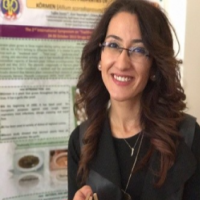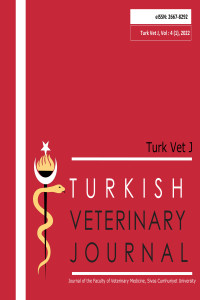Research Article
Clinical Research
Case Report
Aim & Scope
Turkish Veterinary Journal (Turk Vet J), aims to publish articles (original research article, short communication, letters to editor, review article, and case report) on Veterinary basic sciences, clinic or preclinical sciences, zootechnics, animal nutrition, food hygiene and technology both in Turkish or English.
Turkish Veterinary Journal (Turk Vet J) is an international, double peer reviewing scientific journal that publishes by Sivas Cumhuriyet University, Faculty of Veterinary Medicine. Manuscript will be publish should not published before in elsewhere and should be based on the research (except review articles). Turk Vet J is published twice in a year and an open access scientific journal. Special issues may be publishes by the decision of the journal administration. The journal accepts English or Turkish manuscripts. Turk Vet J doesn't asks fee for the processing the article.
Author Guidelines
Turkish Veterinary Journal
About the journal
The Turkish Veterinary Journal (Turk Vet J) is an international peer-reviewed scientific journal published by Faculty of Veterinary Medicine, Sivas Cumhuriyet University, Turkey. The Turkish Veterinary Journal (Turk Vet J) accepts manuscripts (research article, short communication, letter to editor, review article and case reports) in the field of basic sciences, preclinical, clinical, zootechnical, animal nutrition, food hygiene and technologies in English or Turkish languages.
Manuscript may be submitted in the fields of animal sciences if they contain new information of national or international interest and application. Sub-mission of a manuscript implies that it is based on research not previously published. All authors must be aware of and agree to the data presented and conclusions drawn in a manuscript.
Manuscript preparation
Page margins should be 2.5 cm from each edge of the file. It is important that the file be saved in the native format of the word processor used. The text should be in single-column format. Keep the layout of the text as simple as possible. Most formatting codes will be removed and replaced on processing the article. In particular, do not use the word processor's options to justify text or to hyphenate words. However, do use bold face, italics, subscripts, superscripts etc. When preparing tables, if you are using a table grid, use only one grid for each individual table and not a grid for each row. If no grid is used, use tabs, not spaces, to align columns. Note that source files of figures, tables and text graphics will be required whether or not you embed your figures in the text. Consecutive line numbering should be included starting from the section introduction of the manuscript.
Title page should include the title of manuscript, name(s) of the author(s) and their addresses, a short title (running head) and the e-mail address of the corresponding author should be supplied.
The short title should not exceed 60 characters (excluding word spaces). A short title should therefore be an abbreviation of the paper title that will give a brief but accurate description of the main topic of the paper. The main title of the paper may be used in full as the short title if it is not too long.
The title of the paper should be brief but should reflect all aspects of the work published. Generally, titles should be indicative rather than informative, i.e., they should state the subject of the paper rather than its conclusions but should identify the main topics of the paper.
Full given name(s) of author(s) should be used. Do not use initials and, don’t include academic degrees or professional titles. When a paper has several authors from different institutions, key the author to the address with superscript Arabic numerals. (The numeral should follow the author’s name and precede the address.)
An abstract must be included with every paper submitted to the journals. The abstract should express precisely the most important information in the paper and should be intelligible in itself without reference to the paper, since abstracts are often published separately by abstracting journals. Include in the abstract the rationale for the study, the objectives, materials and techniques used, the names of relevant organisms, new theories and terminology and a conclusion. Do not include tables, figures or references or any information not carried in the text of the paper. Avoid acronyms, if possible.
The abstract is published in both English and Turkish. The translation of the abstract also carries a translation of the title and key words. Abstracts of papers should not exceed 200 words. A maximum of six key words or short phrases should be included with the manuscript. These will appear below the abstracts of the paper.
The introduction (no heading, starting from a new page) should state clearly the rationale for conducting the research stating the problem, justifying the research and the findings of earlier research and the objectives of the study.
Subjects, materials and methods used should be described so that the work may be evaluated or repeated by other researchers. Well-known procedures and tests should not be described in detail but simply named or cited as a reference. Chemical procedures that are referenced should include a brief statement of the basic principles of the method.
Results and discussion may be presented as separate sections or combined under one heading. The Discussion section should interpret the data presented in the Results section with regard to the reason for the research presented in the introduction. Relate findings to previous research. Discuss agreement or conflict with previous work. State the conclusions of the research presented and present practical applications and avenues of future study. Scientific speculation should be identified as such; it should be reasonable, firmly founded in observations related in the manuscript and subject to experimentation.
The main conclusions of the study may be presented in a short Conclusions section, which may stand alone or form a subsection of a Discussion or Results and Discussion section.
Cite only references that are highly pertinent. Reference may be made to journal papers, books, theses, dissertations, proceedings, bulletins, reports and published abstracts as well as to unpublished documents held in a library or archive to which the public has access. Unpublished material not accessible to the public such as letters, memos, etc., should be included in the text, followed parenthetically by the statement, “personal communication” or ”unpublished observation”, but should not be included in the reference list. Authors are responsible for ensuring that references are complete and accurate. Do not cite references in the abstract or in the conclusion.
The Turkish Veterinary Journal use the name-and-year system (Harvard system) in which the author’s(s’) surname(s) followed by the year of publication is cited in the text. If there are three or more authors, use the first author’s surname followed by et al., (do not underline or italicize) on all occurrences. The use of parentheses depends on the sentence structure, for example:
Author named in your sentence:
Jones (2004) performed a detailed study on children’s eating habits.
Author cited in parentheses:
The study (Jones, 2004) examined children’s eating habits.
Note: If you do not mention the author’s name in your sentence, the author’s name should be given in the parenthesis. Separate the author’s name and the year of the study with a comma.
Author and year listed in the sentence:
In 2004, Jones performed a detailed study on children’s eating habits.
Note: No in-text citation is needed here because the author and the year of the study are listed in the sentence.
Source with two authors:
As Calhoun and Keller (1997) point out, “Income –based rankings are not the only measure of development”.
Although income-based rankings are important, the “are not the only measure of development” (Calhoun & Keller, 1997).
Note: When you include the authors’ names in your sentence, use the word “and.” If you use the names in the citations, use the ampersand (&).
Three to five authors:
Although income-based rankings are important, the “are not the only measure of development” (Calhoun et al., 1997).
Journal article
Gamelin FX, Baquet G, Berthoin S, Thevenet D, Nourry C, Nottin S, Bosquet L (2009) Effect of high intensity intermittent training on heart rate variability in prepubescent children. Eur J Appl Physiol 105:731-738. https://doi.org/10.1007/s00421-008-0955-8
Book
South J, Blass B (2001) The future of modern genomics. Blackwell, London
Book chapter
Brown B, Aaron M (2001) The politics of nature. In: Smith J (ed) The rise of modern genomics, 3rd edn. Wiley, New York, pp 230-257
Online document
Cartwright J (2007) Big stars have weather too. IOP Publishing PhysicsWeb. http://physicsweb.org/articles/news/11/6/16/1. Accessed 26 June 2007
If the cited author(s) and year are identical for more than one reference insert lower case letters after the year in both text citation and reference list.
Publication Fee:
There is no charge for publication of any type of manuscript. The Turkish Veterinary Journal totally free of charge.
Statement of Human and Animal Rights:
All papers submitted to our Journal should declare agreement with the following ‘statement of human or animal rights’. When reporting experiments on animals or human, authors must indicate that the institutional and national guidelines for human or the care and use of laboratory animals was followed.
Ethical Statements
Naming an author on a paper implies that the person named is aware of the research reported, agrees with and accepts responsibility for any results or conclusions reported. The corresponding author shall ensure that all authors are aware of, agree with, and support publication of the manuscript. When submitting the manuscript, “Ethical Statements” and “Conflicts of Interest Statement” should be provided. Copyright Release Form will be asked, if a manuscript was evaluated and accepted for publication.
Link2: Conflicts of Interest Statement
Contact:
Sivas Cumhuriyet University, Faculty of Veterinary Medicine, 58140, Sivas, TURKEY
Phone: +90 346 219 18 12
Fax: +90 346 219 18 12
E-mail: turkvetj@cumhuriyet.edu.tr
Web: http//dergipark.org.tr/turkvetj
Editor in Chief
Assoc. Prof. Dr. Alparslan COŞKUN
Editor/Managing Editor
Assist. Prof. Dr. Hakan IŞIDAN
Editor
Assist. Prof. Dr. Alper KOÇYİĞİT
Ethical Principles and Publication Policy
Publication processes of Turkish Veterinary Journal are based on producing, developing and sharing knowledge evenhandedly within scientific methods.
Refereed articles are studies require scientific methods and they provide objectivity. All components of publication process (publisher, editors, authors, reviewers and readers) should obey ethical rules for scientific production. Within this context, the policies of ‘publication ethics’ and ‘open access’ also require all components of publication process to obey the ethical principles, in direction of guides and policies of Committee on Publication Ethics (COPE), as “Code of Conduct and Best Practice Guidelines for Journal Editors” and “COPE Best Practice Guidelines for Journal Editors”.
In case we identify that author(s) of the manuscript use(s) falsified and fabricated data, then we will report this to the institution of the authors where he/she works and reject the manuscript. Editorial members of the journal and/or the reviewers reserve the right to ask author(s) to provide raw data which was used in the manuscript.
Ethical Responsibilities of the Publisher
Sivas Cumhuriyet University, the publisher of Turkish Veterinary Journal, is a public-spirited and nonprofit-making public educational institution.
Turkish Veterinary Journal Administrative Committee constitutes Editorial Board of Turkish Veterinary Journal. According the subject of the study, the editor can send an article to some other instructors out of Editorial Board as field editors.
The Responsibilities of Editorial Board of Turkish Veterinary Journal
• Editorial Board of Turkish Veterinary Journal is responsible for all processes of the articles sent to the journal. This responsibility requires deciding independently by considering public interest, not personal gains. The relationship between Publisher and the Editorial Board is based on independence policy, and all decisions of the editors are independent from the publisher and the other persons and institutions.
• Editorial Board of Turkish Veterinary Journal permanently strives to develop and raise the quality of the journal.
• Editorial Board of Turkish Veterinary Journal determines and performs journal policies as publication, blind review, evaluation process and ethical principles.
• Editorial Board of Turkish Veterinary Journal keeps copyrights of the articles published in The Journal of the Institute of Health Sciences of Cumhuriyet University.
• Editorial Board of Turkish Veterinary Journal is responsible for keeping intellectual property rights of authors in publication processes and guarding against unethical behaviors, plagiarism and reference gangs.
• Editorial Board of Turkish Veterinary Journal prepares a “Guide for Authors” to inform authors and “Guide for Reviewers” to inform reviewers about evaluation processes.
• Editorial Board of Turkish Veterinary Journal determines incentive policies for the authors.
• Editorial Board of Turkish Veterinary Journal her keeps records of every article electronically or in written forms.
The Responsibilities of Editors, Editor Assistants and Field Editors
• Editors try to inform reviewers, authors, researchers and readers, to answer their questions clearly within the principles of clarity.
• Editors, during the publication process, consider that the articles should be original and contribute the literature, the readers and researchers.
• While editors are making decisions about the article publication, they consider originality, contribution to the field, clarity of expressions, content and validity and reliability of the articles.
• Editors take the articles without any problem to the preliminary evaluation, consider positive views of reviewers, and they do not change the decisions of the reviewers unless there is a big problem for publishing.
• Editors implement the policies of blind review and evaluation processes, keep private personal identity information of the authors, and provide impartial evaluation processes in due of time for the articles.
• Editors send the articles to field editors and reviewers considering their professional fields, and care that the articles are evaluated impartially and independently.
• Editors, in evaluation processes, consider if there are conflicts or collaborations between authors and reviewers or not.
• Editors generate a large number or reviewers, and they update it consistently.
• Editors prevent non-scientific that do not comply with academic etiquette rules.
• Editors ensure that journal publishing processes are operated in accordance with publishing policies and guidelines, inform those who are in the process of the developments on publishing policies, and prepare training programs when necessary.
• Editors communicate effectively with everyone involved in the publishing processes, and organize meetings at regular intervals.
• Editors provide protection of personal data in assessed articles; they keep personal data of authors, referees and readers.
• Editors attach importance to the protection of human and animal rights in the articles, emphasize that the clear approval of the participants of the article is documented, and rejects the articles witout the approval of the ethics committee on the participants of the article and without any permit in experimental investigations.
• Editors take precautions against misconduct. When there are complaints about the abuse of duty, they share the findings about the subject by conducting an objective investigation.
• Editors provide errors, inconsistencies, or misleading errors in articles to be corrected.
• Editors protect the intellectual property rights of the published articles, and defend the rights of the journal and the author (s) in case of violation. Editors also take the necessary precautions to ensure that the content of the published articles does not infringe the intellectual property rights of other publications; they control authenticity-similarity.
• Editors considers consistent critiques for the articles published in the journal and enables authors to answer these critiques.
• Editors considers the studies including negative conclusions also.
• Editors evaluate the complaints sent to the journal and make necessary statements.
Ethical Responsibilities of Reviewers
The articles in Turkish Veterinary Journal are evaluated by double-blind review in a process, which neither the authors know the reviewers nor the reviewers know the authors; reviewers cannot communicate the authors directly; article evaluation forms and proofreading requests are sent to the authors through the website of the journal. Reviewers must bear the ethical responsibilities in Turkish Veterinary Journals below:
• Reviewers should only accept to evaluate the articles related to the field of their specializations.
• Reviewers should make the evaluation impartially and confidentially. In accordance with this principle, the articles they review should be annihilated after the evaluation process, but they should be used after publication. Nationality, gender, religious beliefs, political beliefs and commercial concerns should not distort the impartiality of the evaluation.
• When reviewers understand that there is a conflict or collaboration, they should inform the editors and refuse to evaluate the article.
• Reviewers must evaluate articles with a constructive attitude in accordance with the academic etiquette rules; they should refrain from insulting and hostile personal comments.
• Reviewers should evaluate the articles they agree on during the evaluation.
Ethical Responsibilities of the Authors
The ethical responsibilities of the authors that apply to Turkish Veterinary Journal as below:
• The authors should not send an article published in or sent to be published in another journal to Turkish Veterinary Journal at the same time.
• The authors should send original articles to Turkish Veterinary Journal. Authors should refer to the sources they use in writing articles in the correct way in the direction of ethical principles.
• Persons who do not contribute to the articles should not be listed as authors, and it should not be proposed to change the author order of a published article and to add authors.
• Reviewers must notify the editors of the conflicts and collaborations about the article.
• In the evaluation process of the articles the authors should provide the editorial staff with information about the articles or the raw data if required.
• The authors must document the rights to use the data they use in their articles, the permission for research or the approval of the participants to whom they have searched.
• Authors should communicate with the editors to provide information, to correct the article or to withdraw it when they are aware of the error associated with the evaluation and early appearance phase or the published article in electronic form.
• The author(s) must specify that they received the ethics committee approval for the researches that require data collection by using quantitative or qualitative methods such as experiment, survey, scale, interview, observation, focus group work that require ethics committee decision; the author(s) must also specify the name of the ethics committee, the date and the number of the ethics committee decision on the first-last page and in the method section of the candidate article. In addition, the author(s) must include information on the fact that the informed consent form was received for the case reports in the articles.
• The author(s) should present proof of their ethical principles for data collection process (such as obtaining permission from others to use their documents such as scale, questionnaire, photograph etc.) in the article. It should be noted in the articles that the copyright regulations for research and publication ethics and intellectual and artistic works are complied with. If the study is conducted on human and animal subjects, it should be reported in the article that the study was carried out in accordance with international reports, guidelines, etc.
• Ethics committee approval is not required for review articles from the author(s). However, it should be stated in articles not requiring an ethics committee decision that the ethics committee decision is not required on the first-last page and in the method section of the article.
Notification of Ethics Non-Principles Status Editor
In case of encountering an unethical situation in articles or about editors, reviewers and authors or in articles that does not comply with the ethical principles regarding in the Turkish Veterinary Journal, it should be reported by turkvetj@cumhuriyet.edu.tr
Cumhuriyet University © ContactULAKBİM Dergi Sistemleri
Price Policy
Ücretsizdir
Indexes
Other Indexes
Journal Boards
Editor in Chief

Editorial Board




Advisory Board


 Web
Web

I obtained my PhD in Pharmacology and Toxicology from University of Plymouth (UK, 2012). On my first Postdoc, performed on the same research facilities for a period of 1 year, I organized and supervised projects of 5 PhD students based on original findings developed through my PhD proving my independent thinking and organizational and supervision skills from very early on my career. In 2013, I moved to Kirkuk University (IRAQ) to further develop my career with a Research Center in Pharmacology and Toxicology Field. There, I specialized on the Pharmacology and Toxicology (2000-2025).
My formation was complemented from the clinical side in the context of Toxicology as I interacted on a daily basis with Prof Caleb Kudi, head of the WHO headquarters leadership team (Plymouth in COTD), acquiring therefore an integral translational background in the study of COTD which revealed me as a precious asset for any translational COTD unit over UK. 2018 I decided to incorporate as the Head of the Department of Pharmacology and Toxicology from the College of Pharmacy.
My main research line was focused on the study of the human and animal changes on its properties were related with Toxicological progression as the altered function of the pesticides is key in toxicant. There, I managed to develop a brand new Research Laboratory from scratch which allowed me to publish several original research manuscripts on the topic. I am currently the leader of the International Association of Veterinary Editors.
The quality of my organization and project management skills are proven by my capacity to establish and maintain an active network which allowed me to publish original research articles in two different laboratories, in two different universities, where I have worked (UK 2007/2012; and IRAQ since 2013), showing my ability to be flexible and well organized in my approaches to research. To date, I have over 100 published peer-reviewed SCI publications (h-index 11, according to Scopus; h-index 14 according to Google Scholar), 2 book chapters, and 10 non-indexed publications. I have been awarded twice as best communication in a conference and performed 11 invited talks (USA, UK, Thailand and IRAQ). I am reviewer of 11 and editor of 3 indexed peer-reviewed journals, member of 8 scientific societies, have reviewed projects for several national and international organizations and have been internal reviewer/examiner of 35 PhD and MSc dissertations. Where I am currently supervising the work of 2 PhD students and a research technician. I have been awarded Diplomate of the European College of Veterinary Pharmacology and Toxicology since 2013,
Finally. I am also involved in public engagement activities being scientific advisor of several toxicological associations (including oximes and several IRAQI societies), having written 8 lay articles in non-scientific journals, performed lay format lectures, and being the coordinator of a science divulgation blog where I also provide original posts and having published lay articles in several media.
Professor Dr. Kasim Sakran Abass
Department of Pharmacology and Toxicology
College of Veterinary Medicine
University of Kirkuk
IRAQ
kasim_abass@uokirkuk.edu.iq

A researcher with a strong background in virology, holding a PhD in Biomedical and Life Sciences. My research focuses on zoonotic viral diseases, with specific interest in studying virus-host interactions, viral immune evasion mechanisms, and viral replication, aiming to develop targeted viral vaccines. I possess advanced technical expertise in molecular biology, computational protein design, and vaccine formulation, enabling me to contribute effectively to efforts in pandemic preparedness against viral diseases.
Secretary

Veteriner iç hastalıklarında dr.






